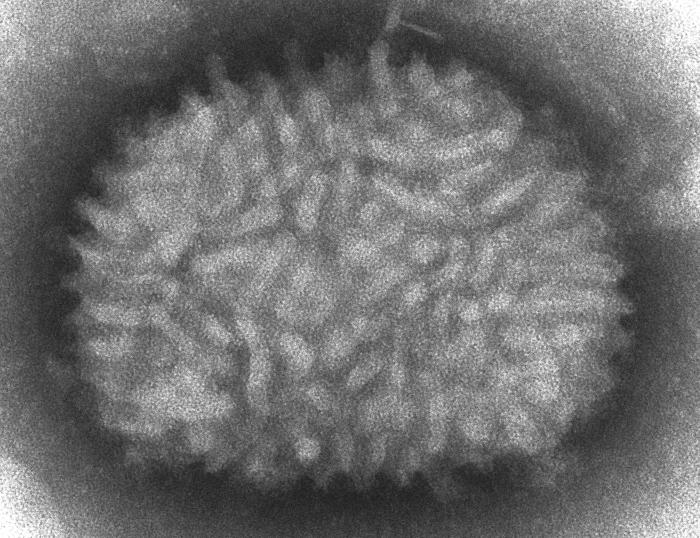Vaccinia

Editor-In-Chief: Prab R Tumpati, MD
Obesity, Sleep & Internal medicine
Founder, WikiMD Wellnesspedia &
W8MD medical weight loss NYC and sleep center NYC
| Vaccinia | |
|---|---|

| |
| Synonyms | N/A |
| Pronounce | N/A |
| Specialty | N/A |
| Symptoms | Fever, rash, lymphadenopathy |
| Complications | Encephalitis, progressive vaccinia, eczema vaccinatum |
| Onset | 3 to 5 days after exposure |
| Duration | 2 to 3 weeks |
| Types | N/A |
| Causes | Vaccinia virus |
| Risks | Immunocompromised individuals, eczema |
| Diagnosis | PCR, serology |
| Differential diagnosis | N/A |
| Prevention | Smallpox vaccine |
| Treatment | Supportive care, antiviral drugs |
| Medication | N/A |
| Prognosis | Generally good in healthy individuals |
| Frequency | Rare, primarily in laboratory settings |
| Deaths | Rare |
Vaccinia is a virus belonging to the Poxviridae family, which is used as a live virus vaccine for the prevention of smallpox. It is a member of the Orthopoxvirus genus, which also includes the variola virus (the causative agent of smallpox), the cowpox virus, and the monkeypox virus. Vaccinia virus is notable for its role in the successful eradication of smallpox, a major achievement in public health.
Structure and Genetics[edit]
Vaccinia virus is a large, complex, enveloped virus with a linear double-stranded DNA genome. The genome is approximately 190 kilobase pairs in length and encodes for around 200 proteins. The virus has a complex structure with a biconcave core and lateral bodies, which are thought to contain enzymes essential for the early stages of infection.
Life Cycle[edit]
The life cycle of the vaccinia virus begins with attachment to the host cell surface, followed by entry into the cell. Once inside, the virus uncoats and releases its DNA into the cytoplasm. Unlike many other DNA viruses, vaccinia replicates entirely in the cytoplasm of the host cell. The virus uses its own machinery to transcribe and replicate its DNA, producing viral proteins and assembling new virions. These new virions are then released from the host cell to infect other cells.
Use in Vaccination[edit]

Vaccinia virus is used in the smallpox vaccine, which was the first successful vaccine to be developed. The vaccine is administered by scarification, a method that involves pricking the skin with a bifurcated needle that has been dipped in the vaccine solution. This method creates a localized infection that induces immunity to smallpox. The use of vaccinia virus in vaccination led to the global eradication of smallpox, declared by the World Health Organization in 1980. The vaccine is still used today for certain high-risk groups, such as laboratory workers who handle orthopoxviruses and military personnel.
Safety and Side Effects[edit]
While the smallpox vaccine is generally safe, it can cause side effects, particularly in individuals with weakened immune systems or certain skin conditions. Common side effects include fever, fatigue, and a localized rash at the site of vaccination. More serious complications, such as eczema vaccinatum, progressive vaccinia, and postvaccinal encephalitis, are rare but can occur.
Research and Applications[edit]
Vaccinia virus is also used as a tool in biotechnology and genetic engineering. Its ability to accommodate large foreign DNA sequences makes it an attractive vector for vaccine development against other infectious diseases and for cancer immunotherapy. Researchers are exploring its use in developing vaccines for diseases such as HIV/AIDS, influenza, and cancer.
See also[edit]
Ad. Transform your life with W8MD's Budget GLP-1 injections from $75


W8MD offers a medical weight loss program to lose weight in Philadelphia. Our physician-supervised medical weight loss provides:
- Weight loss injections in NYC (generic and brand names):
- Zepbound / Mounjaro, Wegovy / Ozempic, Saxenda
- Most insurances accepted or discounted self-pay rates. We will obtain insurance prior authorizations if needed.
- Generic GLP1 weight loss injections from $75 for the starting dose.
- Also offer prescription weight loss medications including Phentermine, Qsymia, Diethylpropion, Contrave etc.
NYC weight loss doctor appointmentsNYC weight loss doctor appointments
Start your NYC weight loss journey today at our NYC medical weight loss and Philadelphia medical weight loss clinics.
- Call 718-946-5500 to lose weight in NYC or for medical weight loss in Philadelphia 215-676-2334.
- Tags:NYC medical weight loss, Philadelphia lose weight Zepbound NYC, Budget GLP1 weight loss injections, Wegovy Philadelphia, Wegovy NYC, Philadelphia medical weight loss, Brookly weight loss and Wegovy NYC
|
WikiMD's Wellness Encyclopedia |
| Let Food Be Thy Medicine Medicine Thy Food - Hippocrates |
Medical Disclaimer: WikiMD is not a substitute for professional medical advice. The information on WikiMD is provided as an information resource only, may be incorrect, outdated or misleading, and is not to be used or relied on for any diagnostic or treatment purposes. Please consult your health care provider before making any healthcare decisions or for guidance about a specific medical condition. WikiMD expressly disclaims responsibility, and shall have no liability, for any damages, loss, injury, or liability whatsoever suffered as a result of your reliance on the information contained in this site. By visiting this site you agree to the foregoing terms and conditions, which may from time to time be changed or supplemented by WikiMD. If you do not agree to the foregoing terms and conditions, you should not enter or use this site. See full disclaimer.
Credits:Most images are courtesy of Wikimedia commons, and templates, categories Wikipedia, licensed under CC BY SA or similar.
Translate this page: - East Asian
中文,
日本,
한국어,
South Asian
हिन्दी,
தமிழ்,
తెలుగు,
Urdu,
ಕನ್ನಡ,
Southeast Asian
Indonesian,
Vietnamese,
Thai,
မြန်မာဘာသာ,
বাংলা
European
español,
Deutsch,
français,
Greek,
português do Brasil,
polski,
română,
русский,
Nederlands,
norsk,
svenska,
suomi,
Italian
Middle Eastern & African
عربى,
Turkish,
Persian,
Hebrew,
Afrikaans,
isiZulu,
Kiswahili,
Other
Bulgarian,
Hungarian,
Czech,
Swedish,
മലയാളം,
मराठी,
ਪੰਜਾਬੀ,
ગુજરાતી,
Portuguese,
Ukrainian